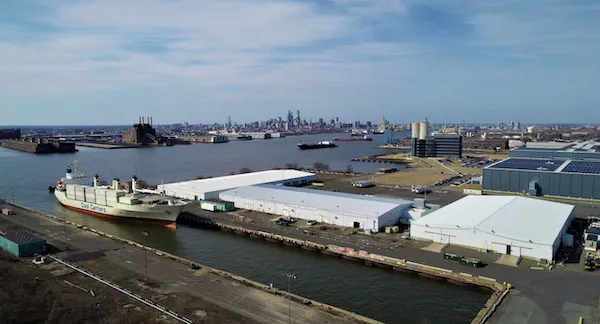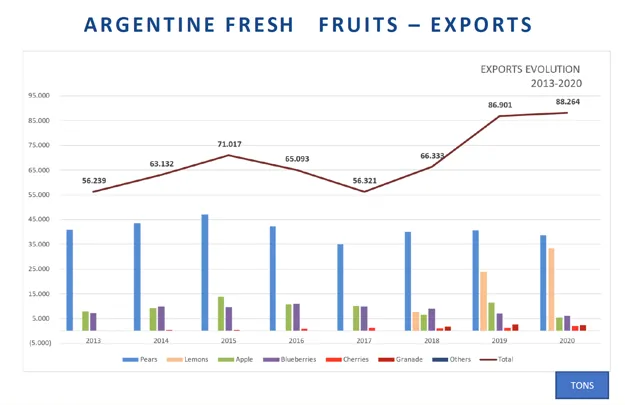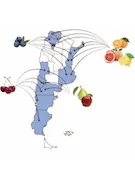On March 16th the Port of Philadelphia and the Embassy of Argentina hosted a webinar to highlight the relationship between the port and Argentina’s produce industry. A panel that included speakers representing every part of the supply chain from producers to customs discussed the trade relationship between Argentina and the Port of Philadelphia, and the role of produce in the port.
 Credit: Holt Logistics.
Credit: Holt Logistics.
Argentinian lemons to the US
Panelists Federico Bayá, representing Fruits from Argentina, and Marcelo Dagna, representing William H. Kopke Jr., Inc., spoke on the developments in Argentina’s fruit production. “Fruits from Argentina is a joint venture between the four most important fruit associations of Argentina: ABC, CAFI, CAPCI, and FEDECITRUS, which represent the blueberry, apple and pear, cherry, and citrus industries, respectively,” Bayá says, adding: “We seek to create great competitiveness in the sector, and we work together to open markets and overcome access barriers.”
One example of this is the recently re-opened market of the United States to Argentina’s lemons. Dagna shares: “Kopke was an important stakeholder in getting lemons approved to enter the US three seasons ago.” Bayá adds: “Argentina is one of the world’s most important exporters of lemons and we are very competitive with a large production window from February through September. Since the reopening of the US market, the volumes sent to the US have grown tremendously – and still continue to expand more. The first season after reopening, Argentina sent 7,000 tons, and last year we hit 35,000 tons.”

Chart courtesy of Fruit from Argentina. Click on photo to enlarge.
Other goals and investments
While the lemons have met great success in the newly reopened US market, Argentina’s other citrus fruits are not allowed on the US market yet. “We need to work together to gain access to the US market for Argentina’s sweet citrus” says Dagna. Bayá agrees: “It would be extremely valuable to the Northeast of Argentina where the sweet citrus is grown.”
Besides citrus, Argentina has also been seeing investments in their cherry industry. “There is a lot of potential for this industry and there has been much investment in quality,” says Bayá. Kopke has also been capitalizing on the potential of this industry, says Dagna: “We believe that Argentina’s cherries stand out for their great flavor and at Kopke we have been working on promoting them in the US.”
Argentina-US logistics  One of the areas for improvement that Dagna points out is that of transit times. “Cutting down the transit time from Argentina to the US is one of our top priorities, specifically for reaching the US west coast. We want to achieve a direct line to the US – currently, after leaving Argentina, we have to stop in Uruguay and Brazil first, which takes a 14-day journey and stretches it to 20-30 days. We did find an alternative in stopping at a Chilean port instead, but it would be in the best interest of everyone in the supply chain to aim for a direct shipping line,” he says.
One of the areas for improvement that Dagna points out is that of transit times. “Cutting down the transit time from Argentina to the US is one of our top priorities, specifically for reaching the US west coast. We want to achieve a direct line to the US – currently, after leaving Argentina, we have to stop in Uruguay and Brazil first, which takes a 14-day journey and stretches it to 20-30 days. We did find an alternative in stopping at a Chilean port instead, but it would be in the best interest of everyone in the supply chain to aim for a direct shipping line,” he says.
Jorge Argüello, the Ambassador of Argentina to the US, explains the importance of the Port of Philadelphia for Argentina: “The Port of Philadelphia is the main port of entry into the US for Argentina’s produce shipments, and throughout 2020 the produce volumes have increased. In 2020, Argentina exported a total of 1.75 billion USD of agro-industrial products to the US, and 27% of that comprised fruit and vegetable exports, totaling 470 million USD. Despite these high numbers, there is still room to grow and there is much work to be done to improve our position in the market.”
The role of the Port of Philadelphia
Sean Mahoney is the Director of Marketing for the Port of Philadelphia. He shares: “The Port of Philadelphia is a leader for perishable and refrigerated products in the US and we are continuing to grow. Throughout 2020 we saw a 7% growth, with a compound annual growth of 11% over the past decade. Our strength is North-South trade, specifically with South America and our core competency is in refrigerated product. In 2020 we handled $3.8 million in fruit products, equaling 4,873,585 metric tons, with largest categories being bananas, followed by pineapple and citrus fruits. In addition to the port, we also own the Philadelphia Wholesale Produce Market.”
Chief Elliot Ortiz of the US Customs and Border Patrol shares that the port’s Transit and Exit (T&E) is one of their strengths. “These shipments come into the Port of Philadelphia and then move on to their final destination – often Canada. So, they have to go through clearance and verification on their way to their final destination. The Port of Philadelphia is unique in our ability to do T&E because we are only about 7 to 10 hours from the Canadian border, depending on which port the ship is heading for, which gives us a great advantage.”
So why has the Port of Philadelphia become one of the most important ports for Argentina fruit? According to the panelists, it’s a combination between the services they offer and their location. “Our location allows us to reach one-third of the US population within one day. This gives us a huge advantage over many other ports. Additionally, there’s our close proximity to the Canadian market, too,” says Chris Ryan of Americold Logistics, who have a cold storage warehouse located in Vineland, New Jersey, forty minutes away from the Port of Philadelphia.
Bayá explains that the services of the Port also add to its value: “I work with blueberries and lemons, both of which need cold treatments. If the cold treatment fails in-transit, then the port of Philadelphia allows us to re-do the treatment, and that’s not a service available in many other ports,” he concludes.
For more information:
María Luz Pereyra
Embassy of Argentina
Tel: +1 (202) 238-6419
Email: luzpereyra@embassyofargentina.us
www.ar.usembassy.gov
